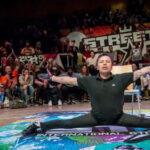As a pole dance instructor, witnessing the journeys of countless dancers has solidified my mission: to cultivate confidence in dancing. This goes beyond mere encouragement; it’s about equipping you with the tangible skills to truly dance, not just perform tricks.
For many, this signifies a transition from years of pole fitness routines to the art of pole dancing. Or, if you’re just beginning, it means prioritizing continuous movement and flow from day one, rather than solely fixating on isolated moves. Regardless of your experience level, certain fundamental skills are universal to becoming a proficient and captivating dancer.
Reflecting on over 350 survey responses about dance and flow, the sheer breadth of skills required became strikingly apparent. The list is indeed extensive, yet these skills can be organized into 10 core categories:
- Body Awareness and Coordination
- Expression
- Fluidity
- Floorwork and Transitions
- Musicality and Rhythm
- Creativity
- Freestyling
- Choreographing
- Developing Your Own Unique Style
- Performing
If thoughts like, “I have no dance background, these skills are foreign to me. I’ll never be a dancer,” are surfacing, dismiss them. Everyone starts somewhere.
This skill list follows a generally progressive order of development, although categories 2, 3, 4, and 5 are somewhat interchangeable. The colored highlights above indicate skills that naturally complement each other. However, attempting to master everything simultaneously can lead to overwhelm and frustration.
Instead, take a moment for self-assessment:
- Evaluate each skill on the list, rating yourself from 0-10 (beginner to expert). Trust your initial impression and jot down a quick score.
- Review your ratings and identify your strengths and areas for improvement.
Done?
NEXT STEP:
- Chart your personal path to pole DANCING and begin integrating these skills into your training. Prioritize your weaker areas, especially those higher on the list. If you score well in the initial categories, shift your focus to the more advanced skills towards the bottom.
To guide you further, here’s how to cultivate these essential dance skills:
#1 Body Awareness / #2 Expression / #3 Fluidity
Body awareness and coordination form the bedrock of expression and fluidity. These are best developed in tandem.
Body awareness entails deeply connecting with each part of your body, genuinely understanding and feeling movement, rather than just mimicking it. This internal connection is crucial for eliminating a “robotic” aesthetic.
Key Principle: Isolate, then Coordinate.
Begin by isolating movements of individual body parts. This can be practiced away from the pole.
Subsequently, “layer” movements – adding and coordinating them simultaneously. If coordination becomes complex, revert to practicing isolated movements.
- Utilize Pole Flow tutorials on Youtube for targeted practice on arms, hands, head, chest, and more.
- Enroll in beginner dance classes across various styles that appeal to you.
Invest time in finding instructors and dance styles that resonate. Certain styles emphasize footwork, while others highlight hips and arms. Ultimately, any practice that enhances your body awareness is beneficial. 🙂
#4 Floorwork and Transitions / #5 Musicality
Key Principle: Temporarily set aside aerial tricks! Focus on floor-based choreography and combinations.
Start with individual movements, transitions, and brief sequences. Progress to practicing entire choreographies synchronized with music.
As you gain confidence with choreography, shift your attention to the nuances of the music. Over time, you’ll develop a keener ear, discerning subtle musical details. This heightened musicality will be invaluable when you begin creating your own choreography.
- Marlo Fisken’s Pole Flow and Floor Flow tutorials are highly recommended.
- Explore quick guided choreographies for beginners within the Pole Flow playlist.
- Attend pole choreography classes at local studios.
- Explore dance classes without the pole. Contemporary dance classes have proven exceptionally helpful for improving floorwork skills.
#6 Creativity / #7 Freestyling / #9 Develop Your Own Style
Key Principle: Cultivate curiosity and open-mindedness. Analyze without judgment.
Fuel your creativity through freestyling. Experiment with diverse movement styles. Begin crafting your own combinations, choreographies, and performances.
This is the path to developing your unique style, a skill that naturally unfolds over time.
- Explore resources like “How to stop thinking which pole move to do next” for freeing your movement.
- Tracee Kafer’s “Finding Your Freestyle” offers further guidance.
- Seek inspiration from @carmineblackdance and @b.brazen for tips on exploring sensuality and movement expression, elements that can enhance various dance styles, including styles sometimes referred to as “Stripper Dancing”.
- Attend classes that encourage explorative freestyles, ideally guided by an instructor.
- Observe and draw inspiration from creative artists across different disciplines.
#8 Choreographing / #10 Performing
Key Principle: Learning through action! Initial attempts may feel imperfect, but experience is the greatest teacher.
Accept that your first performances won’t be flawless. Don’t be discouraged! Every opportunity to choreograph and perform your own piece is invaluable experience that refines your dance artistry.
Resources specifically for choreography and performance are less common, but here are some pointers:
- Participate in studio showcases. The learning experience is immense! Some studios offer dedicated coaching for these events.
- Consider competitions as a subsequent step after studio showcases, but think carefully before applying.
- Find more specific performance tips on this blog.
- Study the work of other dancers and choreographers.
The creative process of choreography is deeply personal. I aim to share more insights into my own creative process in the future.
I trust this overview provides clarity and direction for your pole dance journey. Stay tuned for upcoming posts and tutorials delving into each skill in greater detail.
What are YOUR areas for growth that you’re eager to develop? Share your thoughts in the comments.


